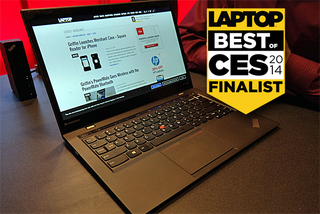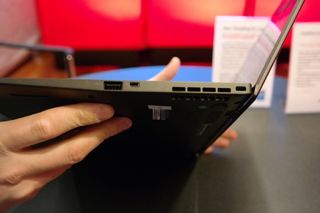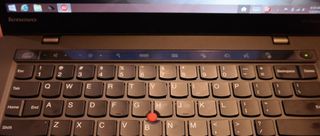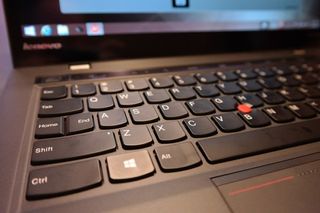Lenovo ThinkPad X1 Carbon 2014: The Keys Change with Your Apps

The Rolls-Royce of business Ultrabooks is getting an upgrade. Lenovo has unveiled the 2014 version of its high-end ThinkPad X1 Carbon Ultrabook, complete with the latest Intel 4th Generation Core Series processor, an optional WQHD screen and 9+ hours of battery life. Available later this month for $1,299, the new Carbon also sports and “adaptive” keyboard with function keys that light up differently depending on the application.
We had a chance to try out the new ThinkPad X1 Carbon here at CES 2014 and like its high-res screen, durable lightweight chassis and innovative function row.
MORE: Top 10 Ultrabooks
Design
At first glance, the 2014 ThinkPad X1 Carbon looks a lot like its 2012-era predecessor. Made of the same durable carbon fiber material, the new model carries the same svelte design, measuring 13. x 8.9 x .68 inches and weighing under 2.9 pounds. That's slightly lighter and thinner than original, which measured 13 x 8.9 x .74 inches and 3 pounds.
Lenovo says that configuring the system with a touch screen increases the weight and thickness slightly, but there's less of a "touch penalty" than on the original X1. Instead of the soft touch surfaces we loved on the original X1 Carbon, the 2014 edition has the same matte black feel as the T440s and X240.

Ports
Like the original, the 2014 X1 Carbon has limited the number of ports to save space, sacrificing some popular connections to stay thin. However, where the original X1 Carbon lacked an Ethernet port and only provided a mini Display port for video out, the new model adds a full-size HDMI out and a proprietary Ethernet port that requires a special adapter cable.
MORE: 10 Laptops with the Longest Battery Life
Stay in the know with Laptop Mag
Get our in-depth reviews, helpful tips, great deals, and the biggest news stories delivered to your inbox.
While requiring a special cable seems like it provides no advantage over using a USB-based solution, native Ethernet allows IT departments to manage and boot the system from a LAN. To make room for those two additional connections, Lenovo dropped the 4-in-1 card reader from the original, forcing anyone who takes photos to carry a card reader.
Adaptive Keyboard
The biggest cosmetic and functional upgrade involves the keyboard, which still has the same island-style design as before, but now features a unique function row made of flat touch-sensitive keys that display different symbols depending on what application you're using. There are only four different symbol combinations: a conferencing set with mic and video controls, a web browser set complete with forward and back buttons, a standard set that has system controls and a set that's just the F1 to F12 keys.

In our brief hands-on, we were impressed when the row changed as we switched from Skype to Internet explorer and other apps, but we wish Lenovo could have taken this technology a step further and made the keys adaptable to any symbol, much like the Razer has done with the full color Switchblade keys on its gaming laptops.
For the first time on a ThinkPad, Lenovo removed the dedicated Caps Lock key and put the Home and End buttons in its place. If you want all caps, you must double tap the left shift key, which has a small green LED which indicates that all caps mode is enabled. We found the keyboard spacious and responsive in our brief time with the X1 Carbon. Like its predecessor, however, the keys are shallower and less tactile than other ThinkPads. There's only so much travel you can fit in a chassis this thin. Like other current-generation ThinkPads, the X1 Carbon now has its trackpoint buttons built into the top of the touchpad.

Motion and Voice Controls
Lenovo also has new options for users who'd rather not type all the time. The ThinkPad X1 Carbon includes Dragon Voice Assistant 1.5 for voice controls, which Intel is bundling with a lot of Ultrabooks. However, it also has gesture control software for eyeSight built in. Though fairly basic, this software allowed us to wave our hand back and forth to switch between songs in a music playlist or push our hand forward to pause or play. Business users will be able to navigate through PowerPoint presentations this way.
Display and Specs
When we reviewed the original ThinkPad X1 Carbon, we were pleased that it offered a 1600 x 900 display as standard rather than the low-res 1366 x 768 panels so many other notebooks have. However, the new X1 Carbon ups the ante by offering an optional WQHD (2560 x 1440) IPS panel with 300 nits of brightness and Lenovo's ColorBurst technology for wide viewing angles. The demo unit we exhibited brilliant colors, whether we were looking at the tiles, the desktop or apps.
On the inside, Lenovo has upgraded ThinkPad X1 Carbon's the CPU to Intel's “Haswell” 4th Generation Core Series with Intel 4400 or 5000 integrated graphics, depending on which processor model you choose. Because of the new processor, Lenovo expects the 2014 X1 Carbon to offer more than 9 hours of battery life, which would be a huge improvement over the 7:45 the original non-touch model got on our tests and the subpar 5:52 the touch version achieved.
MORE: Top 10 Laptops Now
As before, the X1 Carbon has a Rapid Charge feature, which it allows it to reach 80 percent battery capacity after 50 minutes. The laptop now has the port for Lenovo's OneLink dock as part of its power jack so you can charge and dock over a single wire.
Outlook
Overall, the ThinkPad X1 Carbon looks like a very nice upgrade to one of our favorite business Ultrabooks. You get a sharper screen and better battery life in a slimmer and lighter design. The Adaptive Keyboard is the most innovative feature, which we can't wait to test. We look forward to putting the 2014 X1 Carbon through its paces and providing a full review closer to its release date.
